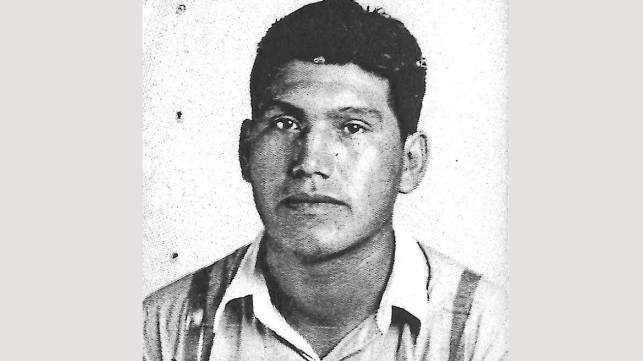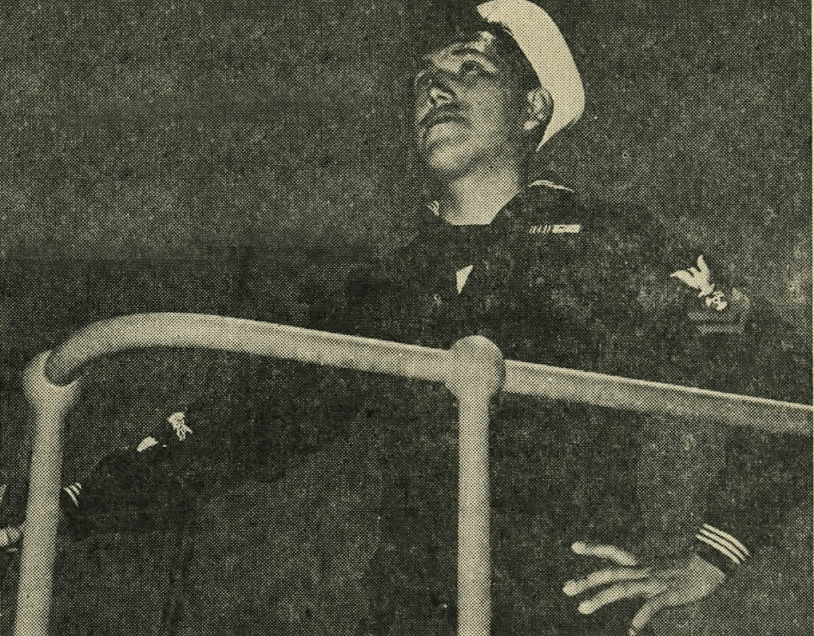FreightWaves Classics is sponsored by Sutton Transport, an LTL leader in the Midwest for more than 40 years. Sutton Transport proudly services Illinois, Minnesota, Missouri and Wisconsin. Request a quote here.

National Native American Heritage Month
In 1990 President George H. W. Bush approved a joint resolution of Congress designating November 1990 “National American Indian Heritage Month.” Similar proclamations, under variants on the name (including “Native American Heritage Month” and “National American Indian and Alaska Native Heritage Month”) have been issued each year since 1994.
FreightWaves Classics joins citizens, organizations and governmental agencies throughout the United States in observing Native American Heritage Month.

Early life
Joseph Robert Toahty, who was half Pawnee and half Kiowa, was born in Oklahoma in 1919. He inherited the name Le-Tuts-Taka (meaning “White Eagle”) from his Pawnee ancestor Chief White Eagle, who served as a U.S. Army scout both during and after the Civil War.
After Toahty graduated from the Haskell Institute for Native Americans in Lawrence, Kansas, he worked as a carpenter at the U.S. Army base at Fort Sill, Oklahoma. In addition, he also served in the Kansas National Guard. Toahty enlisted in the U.S. Coast Guard (USCG) six months before the Japanese attack on Pearl Harbor and other Pacific Ocean holdings. .

Service in World War II
Toahty had six brothers who also served in the U.S. military. He noted, “At one time, my mother had a son in every branch of the service.”
During his Coast Guard service Toahty established notable records for Native Americans. A few months after the U.S. entry into the war, Toahty was deployed to the southwest Pacific, making him the first person of Pawnee descent to go to sea.
A letter that Toahty wrote to friends in Oklahoma from the Pacific Theater was published in the Pawnee Courier-Dispatch newspaper in the fall of 1942. In part, he wrote, “I’m O.K. and still kicking salt water (Thank Heavens). I just wish I could tell you all of the foreign lands and ports I’ve been to and seen, which are plenty, but censorship forbids.”
Among his wartime activities, Toahty took part in the Battle of Guadalcanal between August 1942 and February 1943. The battle, which took place on and near the island of Guadalcanal, was the first amphibious operation and land offensive by the U.S. against Japan.

It was also the first of the U.S. Navy’s famous “island-hopping” operations as well as the first significant test of U.S. Marines against experienced Japanese troops. In addition, it was the campaign where the Coast Guard “forged a relationship with the Marine Corps that grew stronger over the course of the war and continues to this day.”
As a motor machinist mate, Toahty helped operate USCG vessels transporting troops and supplies onto the beaches of Guadalcanal. His role in this battle made him the first Native American to both serve in a major U.S. naval offensive operation and set foot onto enemy territory during World War II.

The Coast Guard’s officers and enlisted men and landing craft kept critically needed supplies flowing to the First Marine Division on Guadalcanal. During the Guadalcanal offensive, the USCG served a key role through its “specialties in maritime transport, amphibious landing and small boat operations.” On ‘the Canal,’ Coast Guard personnel worked seamlessly with USN and USMC counterparts.
The Coast Guard established its own U.S. Naval Operating Base (NOB) on Guadalcanal – the first time in its history. The code name for this small Coast Guard-run navy base was NOB “Cactus.” NOB Cactus had about 30 Landing Craft Personnel (LCPs), which were also known as Higgins boats. Before the war, Andrew Jackson Higgins of New Orleans had been manufacturing shallow-water work boats to support oil and gas exploration in the Louisiana bayous. He adapted his Eureka Boat to meet the military’s specifications for a landing craft. The LCPs were used in the amphibious invasions of Guadalcanal and North Africa in 1942.

There were 50 USCG officers and enlisted men who manned NOB Cactus, including Toahty. The primary mission of NOB Cactus was to ferry troops and supplies from transport ships to Guadalcanal’s beaches.
However, the unit performed other missions as well. They provided a key radio and communications link between land forces and the vessels offshore. Its LCPs and tank lighters navigated the waters off Guadalcanal – as well as islands as far as 60 miles away – landing Marines and retrieving them when necessary. The USCG boats also were used to insert reconnaissance teams led by British Colonial Forces officers behind enemy lines. After aerial dogfights by Navy or Marine fighters against Japanese aircraft, or surface naval battles in nearby “Iron Bottom Sound,” NOB boats took to open water to retrieve wounded Americans and Japanese prisoners. During some of the worst fighting, NOB personnel fitted depth charges on their landing craft and conducted nightly anti-submarine patrols. USCG personnel also pitched-in to defend Marine Corps positions by serving in artillery crews and providing infantry support.
“Adaptability is synonymous with the operations of the United States Coast Guard. …. (the Coast Guard) sometimes lost its identity because it was grouped with the ‘Navy.’ …. recognition of the thousands upon thousands of Coast Guardsmen … is long overdue. …. I know of no instance wherein they did not acquit themselves in the highest traditions of their Service, or prove themselves worthy of their Service motto, ‘Semper Paratus’ – ‘Always Ready’.” – C. W. Nimitz, Fleet Admiral, USN
NOB Cactus living quarters included pre-war coconut plantation buildings, homemade shacks and tents and log-reinforced dugout shelters. The personnel of NOB Cactus frequently used the dugout shelters due to the nearly daily enemy bombing, naval shelling and artillery fire. In one bombardment, Toahty and seven others took cover in one of the shelters. However, the large foxhole suffered a direct hit, killing all of the shelter’s occupants except Toahty and another survivor. Toahty suffered a severe concussion with heavy bleeding from his nose, ears and mouth. After being treated at the Marine Corps infirmary, he returned to duty.
However, like many others at Guadalcanal, Toahty contracted malaria. His malaria was especially severe, which resulted in multiple recurrences and hospitalizations. In January 1943, Toahty rotated off Guadalcanal with other battle-weary men of the Coast Guard and First Marine Division. When Toahty departed, the battle for Guadalcanal had entered its sixth month. By then, the Marines had secured the Allied position on the island and they were relieved by the U.S. Army.

Toahty redeployed to New Zealand where native Polynesians threw an all-day ceremony in his honor. According to Toahty, he “was the first American Indian they had ever seen.” In the village where he was honored, the natives “treated me as if I were a king; and in fact one of the dances they performed was reserved strictly for royalty. I hated to leave that village.”
Because of the severity of his malaria, Toahty was transferred back to the United States after 16 months in the Pacific Theater. He then served in several stateside USCG units.
As a war hero who was “awarded an Asiatic-Pacific campaign ribbon with four stars for valor in the face of danger,” Toahty participated in war bond tours across the U.S. For example, he participated in the “Back Salerno Airmada” with other military heroes and celebrities, such as William “Hopalong Cassidy” Boyd. He later toured with Iwo Jima USMC hero Ira Hayes (who was also a Native American), Medal of Honor celebrity Audie Murphy and the “Hollywood Cavalcade” of movie stars. In 1945, after suffering almost monthly attacks from malaria, he received an honorable discharge.
The Pawnee Chief newspaper noted that Toahty completed his “long and faithful service” in the USCG in 1945.

Post-war
Returning to civilian life, Toahty held jobs at Tinker Air Force Base, wth the U.S. Postal Service and the Oklahoma State Employment Service.
Although it took more than four decades, Toahty was awarded a Purple Heart in 1984 for the wounds suffered from the explosion in the Guadalcanal foxhole. Capt. James Parent of the USCG Office of Personnel noted, “I am very pleased to forward a Purple Heart Medal and Certificate to you for service at Guadalcanal in August of 1942. Men such as you who have made great contributions to the grand heritage of the Coast Guard make me proud to be a member of our service.”
After receiving the medal, Toahty said, “I consider myself proud to be an American and nothing else can stand in the way of that.”
Toahty died in Oklahoma City in 1997 at the age of 77.

(Photo: Shirley Tauer/findagrave.com)
FreightWaves Classics thanks blog.elmc.co, Eastern Overseas Logistics, maritime-executive.com, mycg.uscg.mil, transportationhistory.org, and the University of California, San Francisco, and ww2history.org for information and photographs that contributed to this article.


